Types & Function Of Check Valves
The prime function of a check valve is to protect mechanical equipmenting a piping system by preventing reversal of flow by the fluid. This is particularly important in the case of pumps and compressors, where back flow could damage the internals of the equipment and cause an unnecessary shutdown of the system and in severe cases the complete plant.
Generally speaking check valves have no requirement for operators, and so the valve is operated automatically by flow reversal; however, in very special circumstances this uni-directional facility has to be overridden. Check valves either can be fitted with a device that allows the closure plate(s) to be locked open or alternatively can have the closure plate(s) removed. The latter alternative requires dismantling the valve, removing the plates, and re-installing the valve.
Check valves are automatic valves that open with forward flow and close against reverse flow.
This mode of flow regulation is required to prevent return flow, to main- tain prime after the pump has stopped, to enable reciprocating pumps and compressors to function, and to prevent rotary pumps and compressors from driving standby units in reverse. Check valves may also be required in lines feeding a secondary system in which the pressure can rise above that of the primary system.
Grouping of Check Valves
Check valves maybe grouped according to the way the closure member moves onto the seat. Four groups of check valves are then distinguished:
1. Lift check valves. The closure member travels in the direction normal to the plane of the seat, as in the valves shown in Figure 4-1 through Figure 4-7.
2. Swing check valves. The closure memberswings about a hinge, which is mounted outside the seat, as in the valves shown in Figure 4-8 through Figure 4-10.
3. Tilting-disc check valves. The closure member tilts about a hinge, which is mounted near, but above, the center of the seat, as in the valve shown in Figure 4-11.
4. Diaphragm check valves. The closure member consists of a diaphragm, which deflects from or against the seat, as in the valves shown in Figure 4-12 through Figure 4-14.
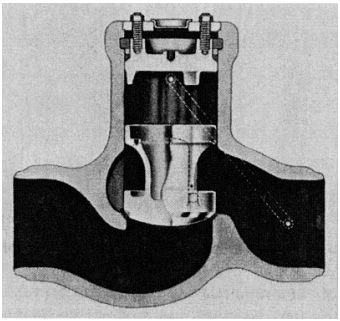
Figure 4-1. Lift Check Valve with Piston-Type Disc, Standard Pattern. (Courtesy of Edward Valves Inc.)
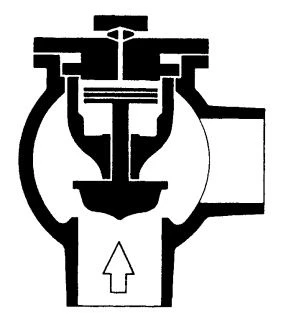
Figure 4-2. Lift Check Valve, Angle Pattern, with Built-in Dashpot, Which Comes Into Play During the Final Closing Movement. (Courtesy of SempellA.G.)
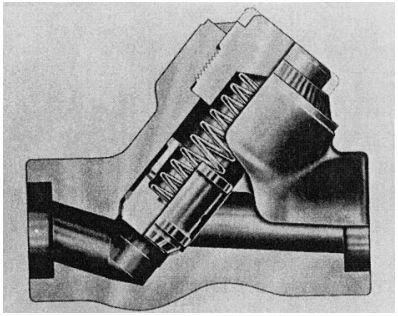
Figure 4-3. Lift Check Valve with Piston-Type Disc, Oblique Pattern. (Courtesy of Edward Valves Inc.)
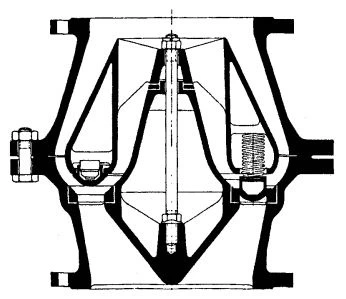
Figure 4-4. Lift Check Valve with Spring-Loaded Ring-Shaped Disc. (Courtesy of Mannesmann-MeerAG.)
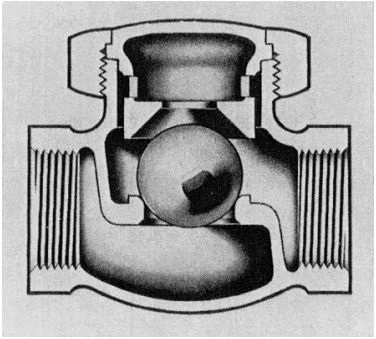
Figure 4-5. Lift Check Valve with Ball-Type Disc, Standard Pattern. (Courtesy of Crane Co.)
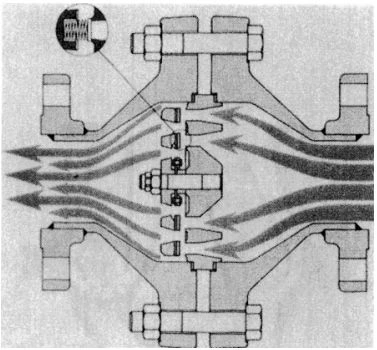
Figure 4-6. Lift Check Valve for Pulsating Gas Flow Characterized by Minimum Valve Lift, and Low Inertia and Frictionless Guiding of Closure Member.
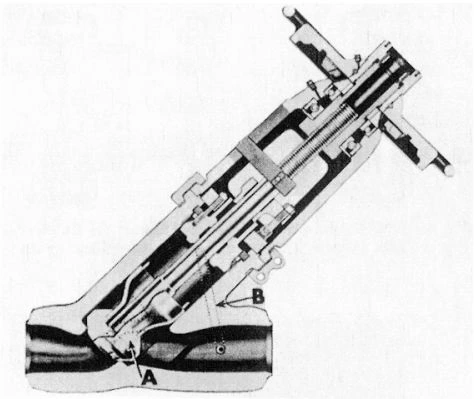
Figure 4-7. Combined Lift Check and Stop Valve with Piston-Type Disc, Oblique Pattern.
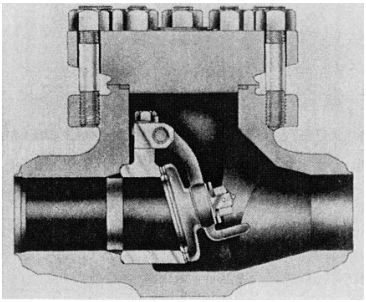
Figure 4-8. Swing Check Valve.
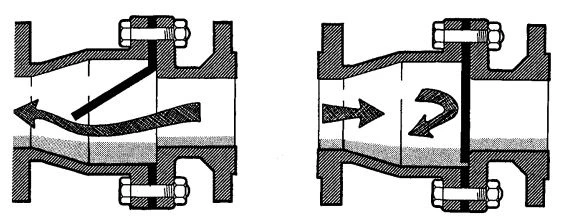
Figure 4-9. Swing Check Valve with Steel Reinforced Rubber Disc, the Disc Being an Integral Part of the Body Gasket. (Courtesy of Saunders Valve Company Limited.)
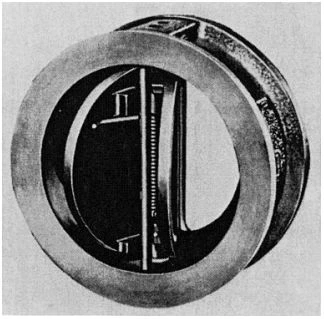
Figure 4-10. Double-Disc Swing Check Valve.
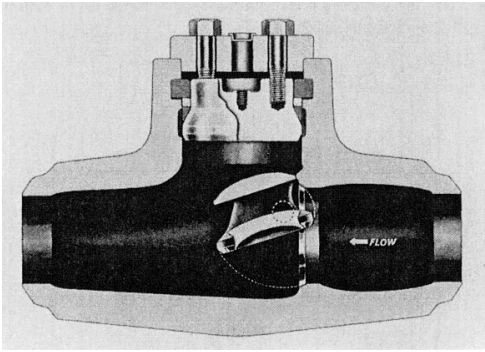
Figure 4-11. Tilting-Disc Check Valve.
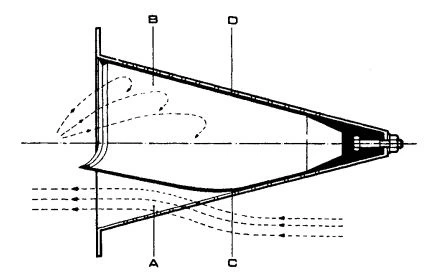
Figure 4-12. Diaphragm Check Valve with Cone-Shaped Diaphragm.
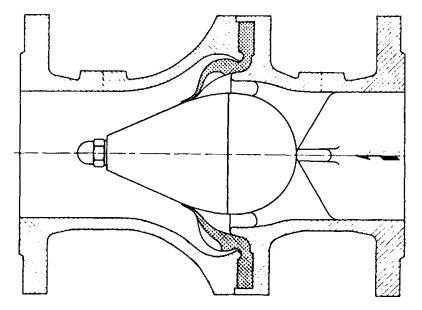
Figure 4-13. Diaphragm Check Valve with Ring-Shaped Pleated Diaphragm.

Figure 4-14. Diaphragm Check Valve, Incorporating Flattened Rubber Sleeve Closure Member.
Operation of Check Valves
Check valves operate in a manner that avoids:
1. The formation of an excessively high surge pressure as a result of the valve closing.
2. Rapid fluctuating movements of the valve closure member.
To avoid the formation of an excessively high surge pressure as a result of the valve closing, the valve must close fast enough to prevent the devel- opment of a significant reverse flow velocity that on sudden shut-off is the source of the surge pressure.
However, the speed with which forward flow retards can vary greatly between fluid systems. If, for example, the fluid system incorporates a number of pumps in parallel and one fails suddenly, the check valve at the outlet of the pump that failed must close almost instantaneously. On the other hand, if the fluid system contains only one pump that suddenly fails, and if the delivery line is long and the back pressure at the outlet of the pipe and the pumping elevation are low, a check valve with a slow closing characteristic is satisfactory.
Rapid fluctuating movements of the closure member must be avoided to prevent excessive wear of the moving valve parts, which could result in early failure of the valve. Such movements can be avoided by sizing the valve for a flow velocity that forces the closure member firmly against a stop. If flow pulsates, check valves should be mounted as far away as prac- tical from the source of flow pulsations. Rapid fluctuations of the closure member may also becaused by violent flow disturbances. When this situ- ation exists, the valve should be located at a point where flow disturbances are at a minimum.
Thefirst step in the selection of check valves, therefore, is to recognize the conditions under which the valve operates.
Assessment of Check Valves for Fast Closing
In most practical applications, check valves can be assessed only qual- itatively for fast closing speed. The following criteria may serve as a guide:
1. Travel of the closure member from the fully open to the closed position should be as short as possible. Thus, from the point of speed of closing, a smaller valve is potentially faster closing than a larger valve of otherwise the same design.
2. The inertia of the closure member should be as low as possible, but the closing force should be appropriately high to ensure maximum response to declining forward flow. From the point of low inertia, the closure member should be of light construction. To combine light- weight construction with a high closing force, the closing force from the weight of the closure member may have to be augmented by a spring force.
3. Restrictions around the moving closure member that retard the free closing movement of the closure member should be avoided.
Application of Mathematics to the Operation of Check Valves
The application of mathematics to the operation of check valves is of relatively recent origin. Pool, Porwit, and Carlton40 describe a calculation method for check valves with a hinged disc that involves setting up the equation of motion for the disc and applying to that the deceleration char- acteristic of the flowing fluid within the system. Before the equation of motion for the disc can be written, certain physical constants of the valve must be known. The calculation determines the reverse flow velocity at the instant of sudden shut-off. The surge pressure due to the sudden shut-off of the reverse flow can then be calculated as described in Chapter 2.
It is important for the valve user to know that valve manufacturers can use mathematics in designing check valves forgiven critical applications and predicting surge pressure.
Selection of Check Valve
Most check valves are selected qualitatively by comparing the required closing speed with the closing characteristic of the valve. This selection method leads to good results in the majority of applications. However, sizing is also a critical component of valve selection, as discussed in the following. If the application is critical, a reputable manufacturer should be consulted.
Check Valves for incompressible Fluids
These are selected primarily for their ability to close without introducing an unacceptably high surge pressure due to the sudden shut-off of reverse ow. Selecting these for a low pressure drop across the valve is normally only a secondary consideration.
The first step is qualitative assessment of the required closing speed for the check valve. Examples of how to assess the required closing speed in pumping installations are given in Chapter 2, page 41.
The second step is the selection of the type of check valve likely to meet the required closing speed, as deduced from page 151.
Check Valves for Compressible Fluids
Check valves for compressible uids may be selected on a basis similar to that described for incompressible uids. However, valve utter can be a problem for high lift check valves in gas service, and the addition of a dashpot may be required.
Where rapidly uctuating gas flow is encountered, compressor-type check valves such as that shown in Figure 4-6 are a good choice.
Standards Pertaining to Check Valves
Appendix C provides a list of USA and British standards pertaining to check valves.
